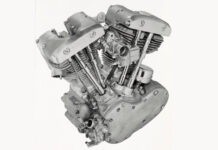Do you know the difference between “noxious” and “obnoxious?” With the impending implementation of California Senate Bill 435 in January 2013, any clear distinction has intentionally and almost irrevocably been obscured. Because the legislature couldn’t figure out, nor afford, a proper emissions test process for motorcycles—and because they are desperate for revenue—they have essentially decided that the one area they could focus on was exhaust pipes. After all, if what’s coming out of the tailpipe is obnoxious then it must also be noxious.
That—literally—is the essence of this new law. Bad as it is, it is only the latest brush stroke on a much larger canvas of well-intentioned bombast, which boils down to more “save us from ourselves” impressionist hodge-podge than revealing insight into the big picture.
When it comes to emissions, as it stands today, these are the facts:
1—You can’t mess with oxygen sensors.
Removing them or even moving them somewhere else is a heavy no-no for the sake of emissions and, truth-be-told, a lame-brained notion for performance improvement as well. Those O2 sensors are the best source of live, dynamic feedback to a really rather smart ECM. The ECM can and will make rapid adjustments to the air/fuel ratio, to the tune (pardon the expression) of roughly 10 percent… if/as needed. Older EFI systems without these sensors were effectively blind, deaf and dumb, by comparison. So, no matter how fantastic these older systems “ran” on the dyno, with (insert brand name here) tuning device “du jour,” it won’t match the flexibility in the real world that bikes using O2 sensors can offer. More about that in a bit (or should that be byte)?
2—You cannot tamper with or remove a catalytic converter.
Let’s be clear here; the massive level of presumed “restriction” a catalytic converter imposes on a Harley engine is, in reality, absolutely minimal. All else equal in the design of the exhaust system, the presence of a factory Monolithic Three-Way Converter on a Touring Harley-Davidson doesn’t make more than a 3–5 percent difference in flow. For the record, a poor choice of slip-on mufflers can hurt performance more than that—no matter how loud and proud you think those mufflers may be. There is really not a performance advantage in removing a cat, but there is hell of an increase in poisonous air.
3—You cannot alter the EPA air/fuel ratio on the so-called “cruise” cycle.
OK—now we get down to it. You will find (if you haven’t already) a proliferation of California-legal tuning devices coming to market from practically everybody who makes one (the Vance & Hines Fuelpak and Harley’s own Screamin’ Eagle Street Tuner being representative examples). What makes a tuner legal is actually pretty straightforward and no big deal when you stop to think about it. These tuners will not adjust air/fuel at engine speeds between idle and 2500 rpm or so. The older, non-California versions will. It’s that simple. Now, before you reject the notion that the legal one is the way to go, ask yourself honestly: how often do you (or can you) really romp on your motor at engine speeds this low? That’s what I thought!
Since there’s no real advantage to tuning for cruising on that first quarter throttle (where you spend 90 percent of your throttle time) and since you can still legally tune your air/fuel at (and for) useful engine speeds—throttle response, torque and peak power are essentially unaffected doing things legally. So why wouldn’t you?
4—None of those facts have anything do with decibels… but this law does!
For the past 20 years or so the EPA has put a legal limitation of the amount of noise (in decibels) motorcycles can “emit.” Yes, Virginia, there are noise emissions! The Feds say 80 decibels is it… end of story. Thing is, the Feds don’t enforce Federal laws. Instead, ever since they became law, enforcement has been left to state and local police. That’s not news… or shouldn’t be. Nor is the fact, for that very reason, enforcement has been—at best—haphazard, ineffective, erratic, nearly nonexistent and more importantly subjective. Any old cop on any old day can write a noise ticket. Not just in California either… it’s endemic to all 50 states. Exactly what has changed with this new SB435 law is also why most states are likely to copy it in the near future.
The message is loud and clear
The logic is a little fuzzy, though! You see the original intent of SB435 was to check motorcycles for clean emissions bi-annually, pretty much the same way cars are checked. Problems abound, however. These dim-bulb politicos would need a lot of expensive dynos to (Ahem!) “monitor” compliance in our relative tiny part of the real pollution problem, precisely because the Federal standards for (noxious) emissions are expressed and measured in grams per kilometer. So a simple sniff test will not do. The economy being what it is, the sharpest edge of the smog sword is lack of funds for test stations and equipment—ironically necessary because of their own damn standards! The other edge is financial as well. Ticket prices and the frequency of penalties for violation—commencing January 1, 2013—will escalate into a serious revenue stream. Nah—won’t dent the big debt, but it’ll keep cops on the payroll, and then some… if you take my meaning. Not that I think the state (any state) would do such things strictly for the money, but that motive (and message) is certainly clearer and liable to be louder over time than the exhaust pipes on Harleys.
Laying down the law
The gist of it is this: officers cannot pull you and your 2013 Harley to the curb just to inspect your exhaust—but once you’re there they sure can. They will be looking for a “stamp”—two actually—a practice called “Label Matching.” One they will expect to be on the mufflers, the other on the VIN tag. Both must confirm, for this poor uninformed public servant, the legal status of your choice of exhaust. For all intents and purposes, the officer has been led to believe that once law, SB435 means nonstock = ticket. Put another way, in their words: “The label match-up, quite simply, eliminates all ambiguity as to what is or isn’t a suitable motorcycle muffler. It greatly lightens the burden on police, who normally would have to place a subjective value like “excessive” or “unusual” on motorcycle exhaust noise, by instead just requiring a simple visual check for the correct muffler label and model specific code. Enforcement is this easy. No sound level meters or special skills are required.”
Sucks!—don’t it? Thing is, it’s still not quite that simple… no matter what they say.
The Intent
So we see the next crackdown on motorcycle (noxious) “emissions” in the form of a no-brainer (obnoxious) loud pipe law! The intent, which I actually understand, is to kill two birds with one stone… or in this case statute. I can already imagine the extra burden on not just owners of next year’s models, but all of us. Not just in California, but in other states where similar laws will almost inevitably be enacted… presuming we (and they) can deal with a few of the more likely unintended consequences. For one thing, I suspect once the law kicks in, the tickets are written and the money starts rolling in, there will be an almost irresistible temptation to ramp-up collecting on old-fashioned noise tickets for those of us who have older machines. For another—and this is important—there already exists a number of aftermarket exhausts that would/could/should be legal under the new law once they get the stamp—if they can. This is where this law gets muddy, messy and mucked-up, because should you choose to use one of ’em you might just have to prove you’re right and the law is wrong… in court… if not to the officer on the spot. There’s a pisser—potentially perfectly legal and not too loud, yet to an ignorant, unyielding SB435 adherent, citable without a silly damn stamp!
The Spirit
Since most of the big players in aftermarket exhaust systems are based in the Golden State it’s a safe bet they will do what they have to, to keep pipes flowing (sorry!) into the market. Still it’s odd that the manufacturer with the clearest lead, so far, is based in Cleveland, Ohio. I speak, of course, of SuperTrapp and their patented (and patently legal) disc system, the basis of their unique “tunable” muffler and maker of (as of now) the only California street-legal (Screamin’ Eagle) slip-ons for Touring models. As a matter of fact, the company made older Screamin’ Eagle systems, sans stamp, some years ago. They continue to make the exact same pipes today and have several that comply with the SAE-J2825 sound test, which was produced by the Society of Automotive Engineers (SAE) International. It is a consistent and economical sound test standard that is used to determine whether an exhaust system for a street bike (or on highway motorcycle in EPA-speak) emits excessive sound. All the same, as your 2012 Harley-Davidson Genuine Parts and Accessories catalog (or an internet search) will show, Screamin’ Eagle slip-on mufflers (notably the Nightstick), all of which are made by SuperTrapp, are perfectly legal and have the stamp to prove it. SuperTrapp’s own versions of the same products have no stamp, but are they really any less legal? Or, for that matter, noisier or prone to polluting?
Can you see from this one single, simple example how convoluted and confusing this could get before long? I don’t know who to feel most sorry for—that poor confused cop or the rider of the bike at the curb.




















